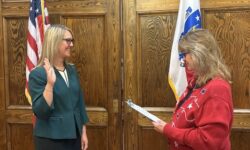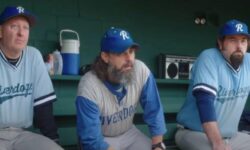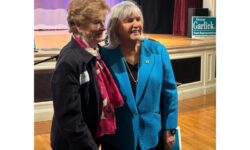By Linda Thomas
Hometown Weekly Correspondent
What Bob Larsen remembers is the continuous rumble, almost like a quiet distant thunder.
It was a storm of sorts, but not a natural one. The noises were artillery, firing from four miles away. The descending shells would fly over his position and explode on targets in front of his platoon.
Larsen spent the last six months of the Korean War on the demarcation line between North and South, Korea, fighting the enemy and helping to police a rogue state.
The Needham man, now 88, said there was always an element of apprehension when artillery shells passed overhead.
“When the shells came from the enemy side, the only warning we had was a quick whistle followed by an explosion,” he said.
He wasn’t frightened.
“I simply had a job to do,” he said.
“We were charged with strengthening the bunkers we were living in so they wouldn’t collapse under an artillery barrage or from the weight of rain soaking the sandbags and bury the men below it.”
When the war ended he came home to the States to his bride and tried to pick up his old life.
Larsen’s wartime experience was important to him, but he didn’t talk about it much until later, when his boys were older and curious about his days at war.
“We would ask him,” said Larsen’s son Jeff, “and he would share.”
There was one lighter side of the story Jeff Larsen remembers his father telling him.
“We were test firing a newly improved mortar we had just emplaced in the position for firing,” recalls the elder Larsen. “The mortar tube had a residue of cosmoline that had not been thoroughly removed. When a round was dropped down the tube, the cosmoline dampened the explosive charge meant to send the round out of the tube and on its way to a target; consequently, it was not sufficiently propelled and fell into a nearby latrine.
“We did not know if the shell was armed and could explode,” he said. “Rather than risk injury or danger we filled in the latrine with earth and dug a brand new one.”
Jeff Larsen said his father isn’t the kind of guy to brag about his accomplishments.
“He felt it was just his duty — he was proud to do it — and he did it the best he could.
“He’d often say, ‘I did what I was told.’”
An Accidental Patriot
When Larsen was growing up in Hampden, CT, war was far from his mind. He said he was a poor student who spent most of his time in class drawing and doodling.
He remembers artists coming into his grammar school with artwork and stories and inspiring the students — and he paid attention then.
As he got older, he enrolled at Yale University School of Fine Arts with a dream of becoming a sculptor. In his second year at Yale, he decided to join the National Guard, fueled not necessarily by patriotism but as a way to earn a little extra cash.
“That changed my entire life,” he said.
“After I was in the Guard and had a chance to talk to other veterans of World War II, I really became interested in what patriotism means to be an American,” he said. “I was seeing firsthand soldiers with whom I was drilling in the National Guard had already served their country in ways that I admired as heroes — and took them as such to be heroes. I wanted to emulate that … that was going to be part of my character and my reason for being a devoted and patriotic American.”
He was part of the 43rd National Guard Division, which was activated when the Korean War broke out in June 1950.
“I wasn’t unhappy about that,” he said. “I saw it as opening up a whole new life’s adventure that many other people would never have had an opportunity to do and now all of a sudden — by accident — I was thrust into a new way of looking at life and America.
“I never gave too much thought of being a super patriot,” he said. “But I became one as a result of my service.”
“A Second Louie”
While in the service of the 43rd National Guard Division, Larsen was invited to take a test, and if passed, would qualify him to attend Officers Candidate School. He took the challenge and was commissioned a second lieutenant — a “second Louie,” he says – in the United States Army.
A year after he received his commission, he was assigned to the 3rd Division and reported for duty in Korea in charge of 24 men in a mortar platoon.
The hills in Korea were steep, Larsen recalls. He compares it to the terrain from Sacramento, Calif., to San Francisco – almost a fault line where centuries ago hills were thrown up by compression of the earth’s crust.
The hills made fighting difficult because anybody advancing against an enemy had to climb a hill just to try to shoot the men at the top. Also, all the fighting was done at night.
“I was never involved that closely,” he recalled. “I was in a mortar platoon and led 24 men firing mortars to keep the enemy at bay and to suppress them so our soldiers on the front line could climb those hills and overrun the enemy.”
Larsen didn’t witness any fallen comrades but saw them suffer injuries. Two of his men were seriously wounded by enemy artillery shell; the lower parts of their legs were nearly blown off.
“There were trenches all the way across the boundary between North and South Korea along the 38th parallel," he said. "They were occupied by ‘grunts’ (soldiers) like me and we mounted all of our armament and artillery and everything upon that line.
“And to make sure the North Koreans understood we meant business we were continually firing artillery shells at their positions in an attempt to make them feel threatened or vulnerable — and likewise they did the same thing to us.”
The fighting ended July 27, 1953, when an armistice was signed, although military hostilities in the region continue to this day.
And Larsen was back home.
Always A Soldier
By then he was 26, and he and his wife, Lizzie, rented a small flat in Providence, R.I. He had enrolled in a one-year program at Rhode Island School of Design on the GI bill to learn to be an illustrator.
The time had come to get a job and make a life for himself and his family.
Soon, Larsen landed a job as a visualizer with the advertising department of General Electric Company in Schenectady, NY, and he spent the next nine years sketching ad layouts for General Electric products. After that he was ready for a change and joined his former colleague in Boston, where they formed a new advertising venture — and Larsen was elevated to art director. He eventually left and became his own “go-to guy” and started a studio, where he took jobs of all stripes.
In 1969, Larsen moved his family to Needham. He became active in town government, civic affairs and the local V.F.W. Fore more than 35 years, he has participated at every Memorial Day, Fourth of July and Veterans’ Day to honor the fallen brave.
He says his time in the service and in combat taught him that he got one crack at life and couldn’t let opportunities pass him by. The same ideals of sacrifice and commitment have carried over in much of his activities and volunteerism working for civic groups and impoverished people.
Throughout his years as an artist, he used his talent to help the people in Bosnia, before that nation was declared a state by the United Nations. He was a member of an organization that gathered shipments of clothing and food to send to Bosnia.
“There were people affiliated with Harvard as well as Jews, Christians and Muslims" -- a potpourri of nationalities, he said, but all with the same agenda.
Every time he sensed there was an injustice in the world, he drew a cartoon. He eventually compiled a series of more than 40 of his illustrations. His son Steven went to Washington, D.C. about five years ago, and took photographs of all of the memorials that the cartoons centered on and he compiled a 40-page book, which he then self-published.
“The book,” he said, “is the cornerstone of my entire career as a patriot.”
Larsen’s drawings and illustrations were his way to get the public to understand and remember the sacrifice and contribution of those who are serving or have served in the armed forces, said his son Jeff.
“My dad has carried with him the belief of commitment and duty. It’s possible his military service was one of the catalysts for that philosophy. He truly believes how important those contributions are — and as an artist he was able to use his talent to honor and remind people of the sacrifices of military service in a different way than we typically honor veterans, such as a parade.”
It rained heavily on Memorial Day 2015. One could see the raindrops misting Bob Larsen’s eyeglasses. But it didn’t make him break his salute.
“I grabbed my large umbrella and held it over him so he could remain in salute posture until that portion of the ceremony was completed,” Jeff Larsen recalls. “He stood there completely erect in his uniform.”
After all, that’s what you do when you’re a soldier.
Editor’s Note: Linda Thomas writes for Hometown Weekly Publications, Inc. For comments and suggestions she can be reached at lindasfaces@gail.com.






















